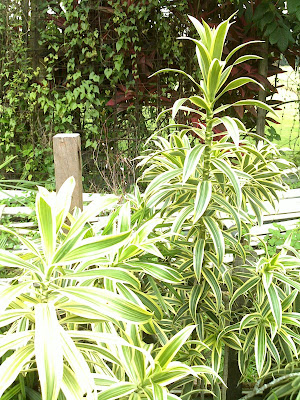FLOWERING SHRUBS AND ANNUALS
Flowering shrubs are amongst the most memorable features of any tropical garden. Though only a few species may fill the air with their frangrance, they still offer a dazzling range of colour and forms. Under this section, you will find quite a number of selections and should you puchase a particular species, rest assured, they will come along with the clay pot. Of course, one can always come down personally to the site to choose your favourite pot!

Lantana camara
Better known as: Lantana
Botanical family: Verbenaceae
Though Lantana is native to South America, it was an early introduction elsewhere in the tropical world, where it soon escaped the confines of gardens and become a weed. This plant is quite a prickly shrub and can grow to a maximum of 1 metre in height (assuming if you give space for it to grow), with ovate rough leaves and clusters of tiney florets, ranging from orange, red-orange, yellow or even white. Lantana grows best under a full sun and well drained soil.
Adenium obesum
Better known as: Desert Rose or Fortune flower
Botanical family: Apocynaceae
Growing to a height of about 1 metre, this succulent plant is native to arid Arabia and East Africa and a member of the family as Plumeria. Its swollent, often twisted trunk is pale grey, leaves are glossy and club-shaped, and the flowers, whoch appear almost continuously, are trumpet-shaped and range from bright pink to crimson.
Adenium is a highly decorative pot plant and can be used in rock gardens. It needs full sun and a well-drained potting mixture. This species is also prized by the chinese as it is associated with wealth and fortune. In our store, we have both the grown and seedlings for your cultivation pleasure.


Hibiscus
Botanical family: Malvaceae
The national flower of our closest neighbour, Malaysia, hibiscus is one flower that is well known to all. Growing in gardens, schools and park, this is one plant that can be found anywhere. In fact, the most common hybrid is called the Hibiscus roas-sinensis and hibiscus 'snowqueen'. Most hibuscus require full sun to flower well and benefit from ocassional pruning, especially when used as a hedge. Of course, it can be grown in pots as well.

Ixora
Botanical family: Rubiaceae
Ixora (from the name of an Indian deity) is native to India and tropical Africa, some of which rival hibiscus as garden shrubs. Ixora javanica blooms are often seen as a sizeable shrub with largish, pointed leaves and red-orange or pure red flowers that appear in rounded clusters of many as sixty at the tips of the branches. Ixora coccinea is amller, with flossy, more ovate leaves, usually red, but there are cases whereby they are white, pink, yellow and orange. In full sun or light shade, ixora flowers can be left to grow on their own, with little or no pruning. When grown as a house plant, it needs high humidity (Singapore is the best for this condition!!), warm temperatures and exposure to strong light.

source: http://www.flickr.com/photos/87453322@N00/2877757919/
Wrightia religiosa
Better known as: Bonsai
Botanical family: Apocynaceae
A shrub that varys in terms of size, from small pots to middle size, about 2 metres tall, from Thailand and Malaysia. IT has slightly pendulous branches, small oval leaves and frequent clusters of small, fragrant white flowers. In terms of management, this is one plant that requires little care beyond the occasional pruning for shape and applications of liquid manure.
Wrightia prefers full sun but will also grow in light shade.
































